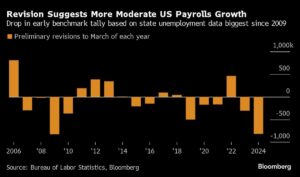Wall Street’s Latest Moves: Decoding the Pressure of Inflation and Tariffs
In recent days, Wall Street traders have felt the heat from economic data that continues to highlight inflationary pressures, bringing clarity to the fact that the Federal Reserve isn’t likely to rush into interest rate cuts. As concerns about rising prices linger amidst trade tensions, investors are left contending with a volatile market landscape.
The Impact of Tariffs and Market Reaction
This week, the S&P 500 saw a decline of approximately 1%, effectively erasing earlier gains. The announcement of reciprocal tariffs by President Donald Trump — set to be revealed next week — only adds layers of uncertainty to an already fragile trade environment. Notably, United States Steel Corp. experienced a significant drop after Trump indicated Nippon Steel Corp. might prefer a direct investment over an acquisition.
With consumer sentiment trending downward and mixed jobs data revealing resilience in the labor market, traders can expect the looming question of inflation to persist. A notable spike in wages has also contributed to this pressure. As major tech stocks, including Amazon, faced disappointing outlooks, the Nasdaq 100 fell by 1.3%, while the Dow Jones Industrial Average slid by 1%.
Fed’s Position in Light of Economic Signals
The latest economic data provides critical insight into the Fed’s strategy. Following three rate cuts last year, policymakers appear poised to maintain current borrowing costs for the time being. While traders speculate another cut may arrive as soon as September, economic indicators suggest a more cautious approach is warranted.
As Seema Shah from Principal Asset Management succinctly states, "The broader picture is still one of labor market resilience and sustained wage pressures," indicating that the Fed will have little incentive to adjust rates imminently. This sentiment is echoed by other financial analysts who argue that a robust labor market is preferable — mild inflation is manageable and historically has not hindered stock market performance.
Hot Job Reports and Wall Street Analysis
The most recent nonfarm payrolls data revealed an uptick of 143,000 jobs last month, with upward revisions in previous months’ figures. Yet, the unemployment rate stands at 4.0%, with wage growth clocking in at 0.5%. While this appears beneficial for consumer spending, as pointed out by Bret Kenwell at eToro, strong wage growth can also stoke inflationary fears among investors.
But is the market right to worry? Analysts seem to agree that while inflation and interest rates play a crucial role in shaping economic policy, the prevailing conditions point towards a healthy economy moving forward.
Neil Dutta of Renaissance Macro Research highlights the possible opportunity within fixed income given the recent data, urging investors to consider the long-term impacts of a high-rate regime. Contextually, Dutta argues, "The Fed is not in a forgiving mood right now," indicating that they are seeking reasons to maintain the current rate landscape.
Future Economic Indicators and Corporate Insights
Looking ahead, upcoming reports such as the January Consumer Price Index will provide more data for the Fed to evaluate its strategy. Historical trends suggest core CPI tends to surprise on the upside in January, with the potential for asymmetric reactions in yield dynamics this year.
In corporate news, several major players are making headlines:
- Amazon has expressed concerns regarding capacity constraints in its cloud computing division despite plans to invest heavily in infrastructure.
- Apple is set to revamp the iPhone SE, aiming to modernize its offerings amid fierce competition.
- Pinterest posted strong revenues, showcasing growth despite larger competitors.
- Cloudflare and Expedia have each reported solid quarterly results, solidifying their positions in their respective markets.
On a cautionary note, Nikola Corp. is navigating potential bankruptcy as it battles through a challenging market.
Market Highlights and Closing Thoughts
As we wrap up the week, here’s a glance at market movements:
- Stocks: The S&P 500 fell 0.95%, the Nasdaq 100 down 1.3%, and the Dow declined by 1%. The Bloomberg Magnificent 7 Index saw a 2% drop.
- Bonds: The yield on 10-year Treasuries advanced to 4.49%.
- Commodities: West Texas Intermediate crude rose to $70.95 a barrel, while spot gold reached $2,861.96 an ounce.
The interplay between tariffs, inflation, and labor market conditions creates a complex narrative for investors and policymakers alike. Keeping a pulse on these developments will be key for navigating the waters ahead.
With the financial landscape changing rapidly, insightful analysis and strategic planning are essential for securing your investment future. At Extreme Investor Network, we’re committed to providing you with the latest insights and actionable strategies to help you thrive in a dynamic market environment. Stay tuned for more updates!

